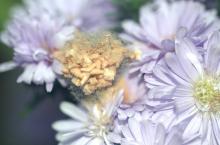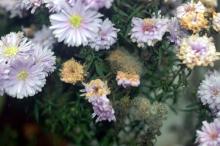See:
Greenhouse Plants, Ornamental - Gray Mold
Cause Botrytis cinerea, a fungus that colonizes dead, dying, and wounded plant parts. From these infections, this fungus can then attack healthy tissues. A moist, humid environment is ideal for the pathogen's sporulation and spread. Conidia may come from sources inside and outside the greenhouse. It is found everywhere asters are grown and has a wide host range. Flower petals are most susceptible at any stage of development.
Symptoms Brown specks form on the petals. The entire flower may turn brown and die. Leaves and stems may also be attacked. Young leaf spots are initially brown and occur on the leaf margin. These spots can enlarge and encompass the entire leaf before extending down the petiole and into the stem. Stem infections can result in dieback above the point of infection. Entire plant may wilt and die if infections occur at the soil line.
Cultural control
- Avoid overhead irrigation.
- Remove all dead and dying plant parts (particularly blossoms) on and around plants.
- Space plants for good air circulation.
- Maintain a steady, relatively dry environment by keeping greenhouse humidity below 90%. Heating the greenhouse at night (especially for zero or negative DIF) or venting around sunset may be necessary. Heating in the morning before sunup can also help prevent dew formation as air temperature increases faster than the temperature of plant parts. If using DROP or DIP for size control, do not let humidity rise above 90%.
Chemical control Best when used with cultural controls. Tank-mix and/or alternate products with different modes of action to prevent the build-up of resistant fungi.
- Astun at 10 to 17 fl oz/100 gal water. Group 7 fungicide. 12-hr reentry.
- Chipco 26019 FLO at 1 to 2.5 quarts/100 gal water. Limit to two (2) applications per year to aid resistance management. Group 2 fungicide. 12-hr reentry.
- Decree 50 WDG at 0.75 to 1.5 lb/100 gal water. Group 17 fungicide. 12-hr reentry.
- Phyton 27 at 1.3 to 2 fl oz/10 gal water. Group M1 fungicide. 48-hr reentry.
- Spectro 90 WDG at 1 to 2 lb/100 gal water. Group 1 + M5 fungicide. 12-hr reentry.
- Terraguard SC at 4 to 8 fl oz/100 gal water. Group 3 fungicide. 12-hr reentry.
Biological control
- LALStop G46 WG (Clonostachys rosea [formerly Gliocladium catenulatum] strain J1446) at 0.13 oz/1 gal water. Do not use with other products in the tank. 4-hr reentry. O
Reference Horita, H., and McGovern, R.J. 2017. Diseases of China Aster. In McGovern, R.J., and Elmer, W.H. (eds.) Handbook of Florists' Crops Diseases. Springer Int.



